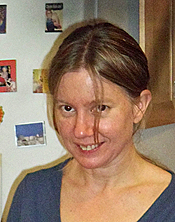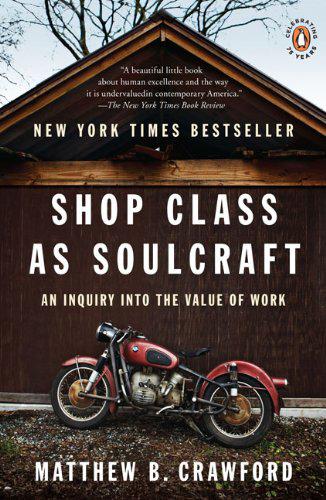"The man who works recognizes his own product in the World that has actually been transformed by his work: he recognizes himself in it, he sees in it his own human reality, in it he discovers and reveals to others the objective humanity of his reality, of the originally abstract and purely subjective idea he has of himself." — Alexandre Kojeve
The best seller, The Millionaire Next Door, by Thomas J. Stanley, revealed that the typical millionaire is your next door neighbor, who drives a pick up and runs his own business in the trades.
Skilled manual labor has often been seen as a mediocre second choice of career. Vocational school has long been considered the path for those unable to deal with the intellectual rigor of college prep classes.
However, Mike Rose in The Mind at Work writes that, "Our testaments to physical work are so often focused on the values such work exhibits rather on the thought it requires. It is a subtle but pervasive omission... it is as though in our cultural iconography we are given the muscled arm, sleeve rolled tight against biceps, but no thought bright between the eyes, no image that links hand and brain."
Maybe learning a trade is not limiting but, instead, liberating. You can't hammer a nail on the Internet. If pipes leak, it's not relative.
"Craftsmanship means dwelling on a task for a long time and going deeply into it because one wants to get it right but in management speak this is called being "ingrown" (Matthew B. Crawford, Shop Class as Soulcraft)
In management everything is relative. There is no direct connection to the end result of one's labor or a sense of ownership or agency. This disconnect has created a resurgence of interest in innovation, entrepreneurship and craft-based manufacturing.
In Maine, this is our history. Small cottage based manufacturing businesses have made up the backbone of our economy since the earliest settlers arrived, and our reputation for craftsmanship is implicit in the phrase "Made in Maine." It means our things are made well and with care. In our global economy where an 'Amish' quilt is often made in China, authenticity and craftsmanship have gained new value.
At the Center for Furniture Craftsmanship, people come from all over the world to make beautiful handcrafted objects in wood. Peter Korn, the founder and executive director, said he thinks "what lures them is the hope of finding a deeper meaning by learning to make things well with their own hands." People often experience this process as transformational.
Maybe, as Crawford posits, "Most forms of real knowledge come from the effort to struggle with and master the brute reality of material objects." One place that this happens on a daily basis in our community is at Mid-Coast School of Technology.
The students at MCST consistently express their appreciation for the many practical, real life skills that they learn there. Many of the courses lead to industry certifications and are rigorous in terms of both skill and thought processes. They teach skills that are in high demand in the workforce, such as machine tooling and video and audio production.
Maybe more importantly, the students have a sense of ownership of both their work and their school. One student made an emergency alarm for the school that could be activated from the main office. "I love the fact that I can make real things that actually get used." It didn't work the first time they tested it. That made the project even better, because he had to figure out what was wrong and fix it. The sense of engagement and joy in learning is palpable. It's not about being right. It's about problem solving. It's not about relative. It's about real.
When was the last time you fixed something or created something? The next time your world seems a little virtual, try picking up a wrench or a pair of knitting needles. You never know where it might lead.
Chris Wohler came to Camden 20 years ago after living in New York for 24 years. She has a Bachelor of Arts in history from Cornell University and a Master of Architecture from Columbia University. She has taught at Ball State University, Parsons School of Design and Columbia University. Her design practice, Breathing Space, encompasses everything from architectural design to retail merchandising.
She likes blackbirds, crosswords, babies, Miles Davis, avocados, quantum physics, Robert Frank, chartreuse, Puccini, roses, graphite drawings, the collaborative process, Great Danes, Patti Smith, gardening, J.S. Bach’s Suites for Solo Cello, architectural plans, movies, Philip Pullman, cooking with friends, everything by Beethoven, New York City and her two sons who currently live there. Reach her at breathingspace2@gmail.com.
Rosie Curtis lives in Camden and teaches architecture at UMA.

Originally from England, she has been designing and building in Midcoast Maine for the last 20 years, although she indulges in a spot of work for a British engineering firm now and then. She holds two bachelor’s degrees and a master’s degree in architecture and has been interested in the built environment her whole life. She believes that design is fundamentally about things working well and looking good. Her two kids are fed up of hearing her pontificate about all things design related and hope this column will provide a channel for her endless wonderings. Reach her at rosieacurtis@gmail.com.
More Design Notes:
• Design Notes: An introduction
• The Welcome Mat: The story of front and back
• Moments of Delight 1: Boynton–McKay Food Co.
• Is It Food Or Is It Art? Rockland's Main Street
• The domestication of the garage
• The utility of Maine style: From barrel staves to clapboards


Lathe.jpg)


























